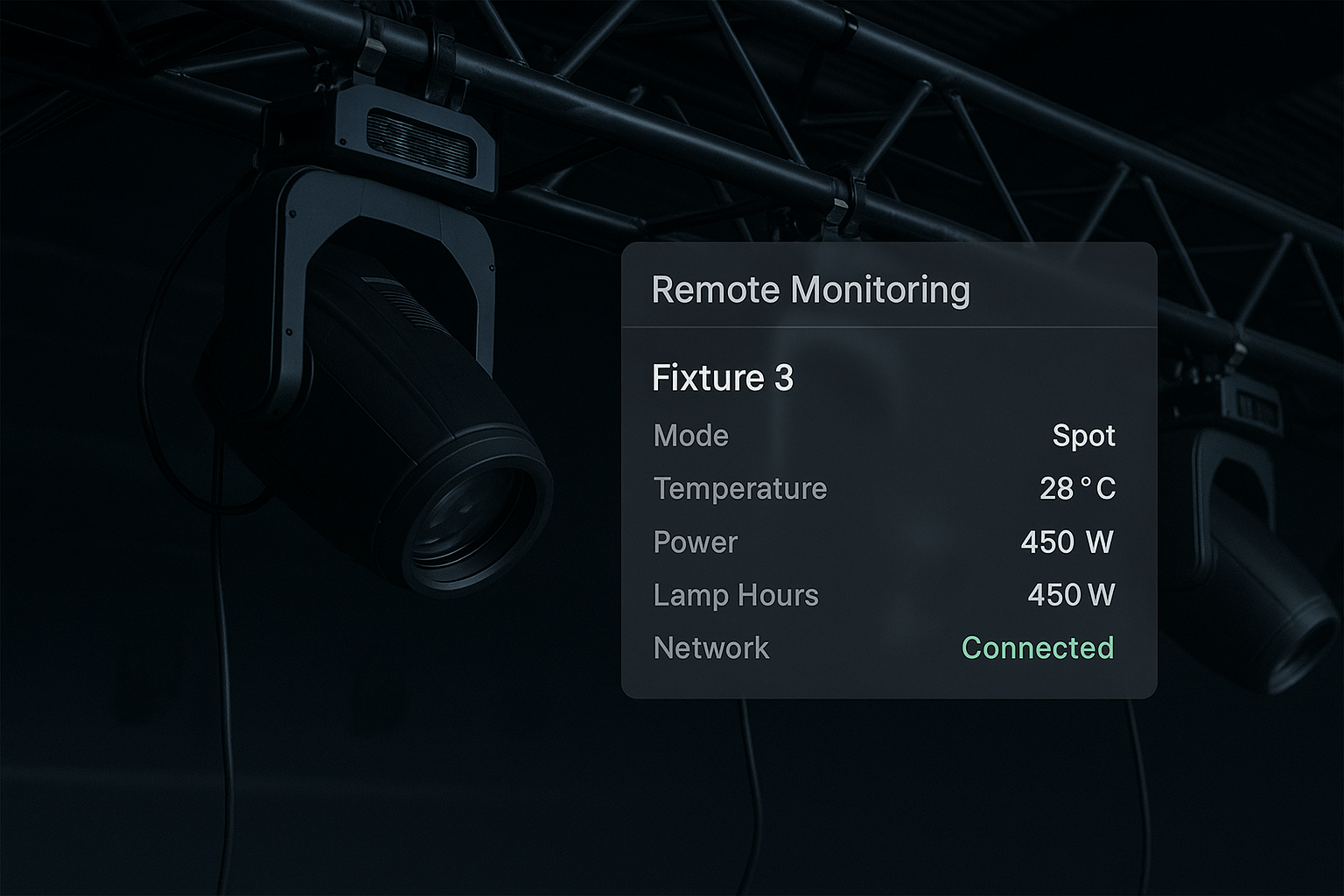The Need for Real-Time Oversight
As modern lighting systems grow in scale and complexity, managing them manually becomes increasingly inefficient—and risky. Whether in live entertainment, touring productions, architectural installations, or broadcast environments, the ability to remotely monitor lighting fixtures is quickly becoming an industry standard.
Remote access provides a window into the real-time performance and condition of every fixture on your network. It allows lighting designers, technical directors, and maintenance teams to view key operational data, anticipate failures, and make critical adjustments—without physically climbing trusses or interrupting ongoing programming.
What Does Remote Fixture Monitoring Include?
Remote access doesn’t just mean turning lights on and off from a distance. With the right infrastructure, you can track an array of metrics, including:
Fixture temperature
Fan speed
Lamp/LED runtime hours
DMX signal status
Position feedback
Color engine status
Error codes and log reports
Power consumption
Network status (Wi-Fi or Ethernet)
Advanced systems can even issue automated alerts when thresholds are exceeded (e.g., overheating), or when maintenance is due based on usage patterns.
How Remote Monitoring Works
Remote fixture monitoring relies on a combination of hardware, software, and network infrastructure:
1. RDM (Remote Device Management)
RDM is a DMX protocol extension that allows bidirectional communication between consoles and fixtures. It lets users retrieve information and configure settings from compatible controllers.
2. Art-Net/sACN over IP Networks
Many modern fixtures support remote monitoring via IP protocols like Art-Net or sACN. These enable data transmission over standard Ethernet networks—often in combination with lighting control software or node management platforms.
3. Proprietary Monitoring Platforms
Manufacturers offer their own software for in-depth diagnostics. These dashboards offer visual overviews of entire lighting rigs, often including drag-and-drop floorplans, error notifications, and performance history.
4. Cloud-Enabled Gateways
More installations now use cloud-linked hardware that connects the lighting network to secure remote portals. Technicians can access these portals from anywhere using a mobile device or computer.
Benefits Across Production Environments
Live Tours
For touring shows, road crews often operate under tight schedules with minimal prep time. Remote access allows techs to:
Check lamp hour limits before hitting the next city
Spot issues like fan failure or overheating early
Remotely calibrate fixture positions in new venues
Fixed Installations
In permanent installs like museums, theme parks, and architectural sites, accessing lights may require scaffolding or lifts. Remote monitoring:
Reduces downtime by identifying issues before failure
Helps prioritize maintenance during off-hours
Logs fixture history for service reporting

Broadcast and Studio
In television and film environments, quiet operation and fixture stability are critical. Remote monitoring helps teams:
Maintain ideal color temperatures across takes
Identify fan anomalies before they affect sound
Reduce manual inspection between shoots
Preventing Failures with Predictive Maintenance
One of the key advantages of remote access is enabling predictive maintenance. Instead of reacting to issues when they become visible (flickering, color drift, noise), systems can notify users when a fixture:
Is nearing lamp replacement hours
Has operated in high heat for extended periods
Registers erratic data suggesting potential electronic failure
This allows crews to act preemptively—swapping out gear before the audience ever notices a problem.
Integration with Centralized Control Systems
Many advanced lighting control platforms now include integrated health monitoring. These systems offer:
Live status dashboards
Color-coded fixture health icons
DMX universe diagnostics
Automated error logging
Remote firmware updates
Operators can run a pre-show check and view fixture health at a glance. In some cases, integration with building management systems (BMS) or show control platforms (e.g., OSC, Crestron) allows lighting health data to inform wider automation.
Security and Access Control
Because remote monitoring involves network connectivity, security is essential. Best practices include:
Isolated VLANs for lighting devices
Strong passwords and encrypted protocols
Role-based access control (e.g., lighting techs vs. admin)
Audit logging of remote commands
Cloud-based remote platforms should offer two-factor authentication and encrypted tunnels (e.g., VPNs) to prevent unauthorized access.
Limitations and Challenges
Despite its advantages, remote access still presents challenges:
Compatibility: Not all legacy fixtures support RDM or network monitoring
Infrastructure cost: Ethernet wiring, switches, and nodes can increase initial budgets
Training: Technicians must understand network protocols, not just DMX
Latency: Real-time feedback can lag over long-distance cloud connections
Designers and integrators should weigh these factors and develop hybrid approaches when necessary.
Future Outlook: Smarter, Simpler Monitoring
As lighting systems become increasingly intelligent, expect future remote monitoring capabilities to include:
AI-based anomaly detection
Voice alerts or app push notifications
Remote scene simulation with fixture status overlays
Energy usage dashboards for sustainability tracking
Self-healing systems that reroute DMX paths or reboot faulty fixtures automatically
Remote monitoring is quickly evolving from a “nice-to-have” to a “must-have” feature in mid-to-large scale productions.
Conclusion: Peace of Mind from a Distance
Remote access to fixture status gives lighting professionals greater control, foresight, and flexibility. It enables proactive management, safer working environments, and fewer on-site interventions. Whether you manage hundreds of lights across a stadium or need to troubleshoot a single truss in a theater balcony, the ability to monitor fixture health remotely ensures smoother shows, longer fixture life, and happier crews.
READ MORE:





Blue Sea Lighting is an enterprise with rich experience in the integration of industry and trade in stage lighting and stage special effects related equipment. Its products include moving head lights, par lights, wall washer lights, logo gobo projector lights, power distributor, stage effects such as electronic fireworks machines, snow machines, smoke bubble machines, and related accessories such as light clamps.
Quick Links
For more questions subscribe to our email








